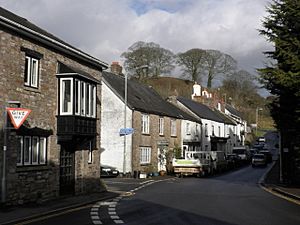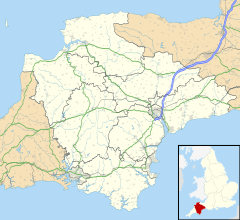Bampton, Devon facts for kids
Quick facts for kids Bampton |
|
|---|---|
 Castle Street, Bampton |
|
| Population | 1,260 (2011 UK Census) |
| OS grid reference | SS957222 |
| District | |
| Shire county | |
| Region | |
| Country | England |
| Sovereign state | United Kingdom |
| Post town | TIVERTON |
| Postcode district | EX16 |
| Dialling code | 01398 |
| Police | Devon and Cornwall |
| Fire | Devon and Somerset |
| Ambulance | South Western |
| EU Parliament | South West England |
| UK Parliament |
|
Bampton is a small and historic town. It is located in northeast Devon, England. The town sits by the River Batherm, which flows into the River Exe.
Bampton is about 6 miles (10 km) north of Tiverton. It is also 19 miles (31 km) north of Exeter. The area around Bampton touches the county of Somerset. In 2011, about 1,260 people lived in Bampton.
Contents
Bampton's Past
Early History: Romans and Saxons
Bampton's story might have begun with a Roman fort. But we can see more signs of the later Saxon times. Some old hedges follow Saxon measurements. You can also see traces of Saxon strip farming near where the castle was built later. Even the round shape of the churchyard is from Saxon times.
Norman Times and Bampton Castle
Around 1067, the Norman Bampton Castle was built. Walter Douai or his son, Robert, built it. It probably had a wooden tower on a large earth mound, called a Motte. There was also a protected area called a bailey.
Later, Robert Douai had a disagreement with King Stephen. King Stephen then attacked the castle. The castle eventually gave up. Robert fled, and his lands were given to Henry de Tracy.
The English Civil War
The English Civil War reached Bampton in 1645. Royalist soldiers from Tiverton Castle burned down much of the town. This is why most buildings in Bampton today are from after the 17th century.
Important Buildings in Bampton
Bampton has over 70 listed buildings. These are buildings that are important for their history or special design.
The most important is the church of Saint Michael and All Angels. Its tower is from the 13th century. The church was made bigger in the 1400s and fixed up in 1872.
In the small village of Petton, which is part of Bampton parish, there is a tiny church called Saint Petrock. Some parts of the old vicarage (where the church leader lived) are from the mid-1400s. The Exeter Inn, a pub, was first built as a farmhouse in 1495.
Bampton Fair
The Fair's Long History
The Bampton Fair started a very long time ago. It was officially allowed by a Royal Charter in 1258. A charter is like a special permission from the King. The fair happens every year on the last Thursday in October. It might even be older than 1258!
In the early days, people selling goods at the fair paid tolls. These were paid at a special booth. The fair was known as Saint Luke's fair for many years. This was because it was held on Saint Luke's feast day.
Fun and Entertainment
The fair has always offered many kinds of fun. In the past, there were mystery plays about the Bible. Later, plays were about myths and history. There were also bear baiting, jugglers, acrobats, and puppet shows. People could watch boxing and wrestling matches too.
Changes Over Time
In the 1920s, a miners' strike meant many pit ponies were sold. Prices at Bampton Fair dropped very low. Some ponies were even given away for free in 1928.
In 1972, the town council took over running the fair. They became responsible for things like cleaning up and managing traffic. Brook Street was closed to cars on fair days. The funfair part of the fair moved to the Station Car Park in 1973.
After 1985, fewer ponies were sold. The fair started to have more food stalls. A group called the Bampton Fair Working Group was set up in 1990. They still help organize the fair today.
Pony Sales at the Fair
Bampton Fair became famous for selling ponies in 1856. This was when Frederick Knight started selling his ponies there. Exmoor Ponies were gathered from the moors. They were then walked to the fair to be sold.
The ponies were kept in wooden pens behind the Tiverton Hotel. People paid a fee to see the ponies. In the 1970s and 80s, there were some concerns about how the ponies were treated. The RSPCA (a charity for animals) and vets worked with the council. They made suggestions to improve the ponies' welfare. By 1985, the RSPCA was happy with how the fair was run.
However, the council decided not to spend money on big improvements for the pens. So, the pony sales at the fair ended. From 2004 to 2013, some ponies were auctioned a little way out of town. But this also stopped because fewer people wanted to buy ponies this way.
The Fair Today
The Bampton Fair is still a very popular event. It happens during the school half-term break. Today, you can find a traditional funfair. There is also a busy street market. It sells fun new items and local foods from the West Country.
Twin Towns
Bampton is twinned with Villers-Bocage, Calvados, France. They became twin towns in 1975.
Historic Estates
- Duvale
See also
 In Spanish: Bampton (Devon) para niños
In Spanish: Bampton (Devon) para niños


